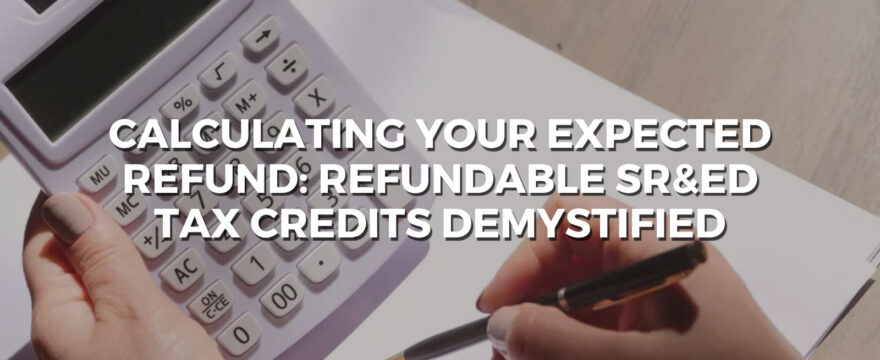
In Canada, the Scientific Research and Experimental Development (SR&ED) program supports and encourages businesses engaged in research and development (R&D) work. SR&ED provides support by offering companies the opportunity to recoup a significant portion of their R&D investments through refundable and non-refundable tax credits. Below, we will cover calculating your potential refund through refundable SR&ED tax credits and how Easly can enable you to leverage those earned tax credits to access capital.
Understanding Refundable SR&ED Tax Credits
The SR&ED program provides Canadian businesses with valuable incentives for conducting R&D activities that drive innovation. Refundable tax credits are a core component of this program. Unlike non-refundable tax credits, which can only reduce taxes owing, refundable tax credits can result in a direct cash refund to your business. Meaning that you receive a set amount of funds regardless of how much income tax you pay. This makes the refundable tax credits awarded through the SR&ED program a powerful asset for startups and growing companies looking to reinvest and finance their innovative projects.
How is the SR&ED Tax Credit Calculated?
Most companies that claim SR&ED opt to use the “proxy method” rather than the “traditional method” in order to determine the overhead costs they can include in their SR&ED claim. In this blog post, we’ll focus on the proxy method. You can find out more about both the proxy and traditional methods here.
To begin, combine your eligible expenditures within three categories: payroll, materials, and sub-contracts. For payroll, maintain a record of those directly engaged in performing qualifying activities, noting their dedicated hours to the tasks. If compensation is hourly, apply the actual hourly rate; for salaried employees, calculate the portion of their annual work hours spent on SR&ED-eligible projects and multiply that by their annual salary. Once you’ve totalled the salary base eligible for SR&ED, multiply it by 1.55 to add in the prescribed proxy amount meant to represent overhead costs.
When it comes to sub-contractors, combine the invoiced amounts for specific projects; typically, only 80% of the accumulated value is deemed eligible for SR&ED tax credits.
Regarding materials, you can include expenses tied to prototype construction and the consumption of materials during your SR&ED experiments. The cost of procuring and storing the materials can also be claimed. This includes shipping and duties paid.
Once your cumulative expenses are established, the next step is to apply the appropriate percentage to determine your anticipated SR&ED credit. If your enterprise is a Canadian-Controlled Private Corporation (CCPC), you’ll most likely qualify for a 35% refundable tax credit on your eligible expenditures from the federal government. Depending on where your business is headquartered, you may be eligible for additional R&D tax credits from your provincial or territorial government. In order to accurately calculate your expected refund, it’s recommended to collaborate with a professional advisor who specializes in this area.
SR&ED Tax Credit Calculations Simplified
Calculating the exact amount of SR&ED tax credits can be complex due to the intricacies of eligible expenditures, project scope, and the nature of innovative activities. However, for many Canadian companies, gaining a rough idea of your potential refund is a valuable step toward making an informed decision regarding your R&D investments.
For businesses seeking a preliminary estimate, tools like Easly’s SR&ED calculator can be a helpful starting point. Easly’s SR&ED calculator estimation tool is designed to provide a rough idea of the potential refundable tax credits you may be eligible to receive. By inputting some basic information, you can get a preliminary estimate that helps you gauge the financial impact of your innovation efforts.
Please note: while Easly’s SR&ED calculator estimation tool offers a convenient way to get a preliminary idea of your potential returns, keep in mind that the actual calculations involve a more intricate process.
Don’t Wait to Receive Your SR&ED Refund: Partner with Easly!
SR&ED refunds are only disbursed annually, after the claim is submitted and approved by the CRA, which, for many Canadian businesses, makes it difficult for them to receive the financial support they require to continue their research and development (R&D) work. However, by partnering with Easly, your company can tap into your earned SR&ED tax credits in as little as two weeks!
At Easly, we provide non-dilutive capital on a schedule that works for you. Contact Easly and start financing your SR&ED tax credits today!
.png)
.png)
.png)
